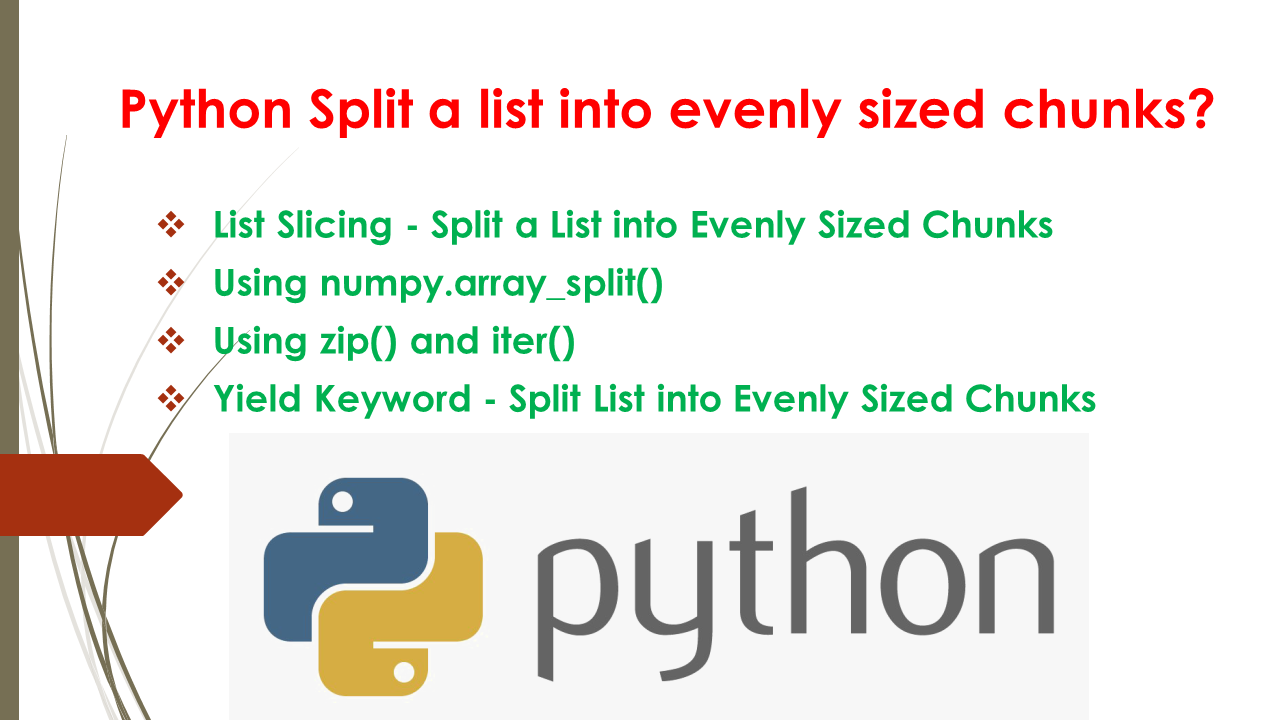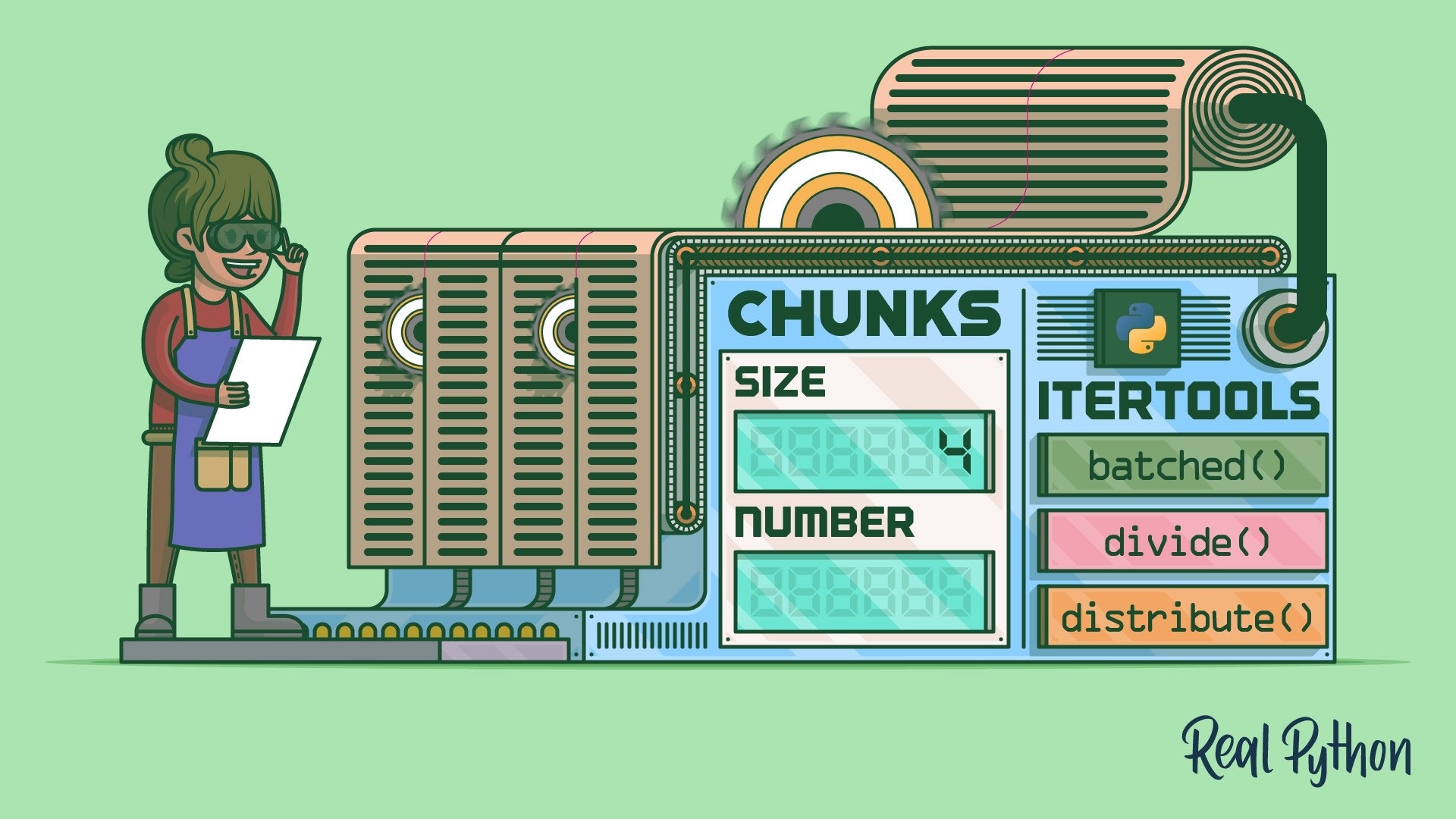Python Split List into Chunks
Learn how to efficiently split a Python list into chunks of equal size for easier data processing and manipulation.
Learn how to efficiently split a Python list into chunks of equal size for easier data processing and manipulation.
In Python, it's often necessary to divide a list into smaller, equally sized chunks for processing. This article demonstrates various techniques to accomplish this, along with explanations and examples.
Let's explore how to split a Python list into chunks of equal size.
1. Using Slicing
Slicing is a fundamental Python concept. We can use it to extract portions of a list.
my_list = [1, 2, 3, 4, 5, 6, 7, 8, 9, 10]
chunk_size = 3
chunks = [my_list[i:i + chunk_size] for i in range(0, len(my_list), chunk_size)]
print(chunks) # Output: [[1, 2, 3], [4, 5, 6], [7, 8, 9], [10]]Explanation:
my_list and want to divide it into chunks of size chunk_size.range(0, len(my_list), chunk_size) generates a sequence of starting indices for each chunk (0, 3, 6...).my_list[i:i + chunk_size] extracts a slice of the list from index i to i + chunk_size.2. Using the zip() Function
The zip() function is handy for combining elements from multiple iterables.
my_list = [1, 2, 3, 4, 5, 6, 7, 8, 9, 10]
chunk_size = 3
chunks = list(zip(*[iter(my_list)] * chunk_size))
print(chunks) # Output: [(1, 2, 3), (4, 5, 6), (7, 8, 9)]Explanation:
iter(my_list) creates an iterator from the list.[iter(my_list)] * chunk_size replicates the iterator chunk_size times.zip(* ...) "unzips" the iterators, grouping elements into tuples.list().Important Note: The zip() method will only include complete chunks. If the list doesn't divide evenly, the remaining elements are discarded.
3. Handling Leftover Elements
If you want to include the remaining elements in a smaller last chunk, you can modify the slicing approach:
my_list = [1, 2, 3, 4, 5, 6, 7, 8, 9, 10, 11]
chunk_size = 3
chunks = [my_list[i:i + chunk_size] for i in range(0, len(my_list), chunk_size)]
if len(chunks[-1]) < chunk_size:
# Pad the last chunk if needed
chunks[-1] = my_list[-chunk_size:]
print(chunks) # Output: [[1, 2, 3], [4, 5, 6], [7, 8, 9], [9, 10, 11]]This code adds a check after chunking. If the last chunk's size is less than chunk_size, it reassigns the last chunk to include the last chunk_size elements of the original list.
These are some common ways to split a Python list into equally sized chunks. Choose the method that best suits your needs and coding style.
The code demonstrates three ways to split a list into smaller chunks of a specified size in Python. The first method uses list slicing within a list comprehension to create chunks. The second method utilizes the zip() function with iterators to group elements into chunks. The third method builds upon the slicing approach and includes additional logic to handle leftover elements when the list length is not perfectly divisible by the chunk size, ensuring all elements are included in the chunks.
# 1. Using Slicing
my_list = [1, 2, 3, 4, 5, 6, 7, 8, 9, 10]
chunk_size = 3
chunks = [my_list[i:i + chunk_size] for i in range(0, len(my_list), chunk_size)]
print("Using slicing:", chunks)
# 2. Using the zip() Function
my_list = [1, 2, 3, 4, 5, 6, 7, 8, 9, 10]
chunk_size = 3
chunks = list(zip(*[iter(my_list)] * chunk_size))
print("Using zip():", chunks)
# 3. Handling Leftover Elements
my_list = [1, 2, 3, 4, 5, 6, 7, 8, 9, 10, 11]
chunk_size = 3
chunks = [my_list[i:i + chunk_size] for i in range(0, len(my_list), chunk_size)]
if len(chunks[-1]) < chunk_size:
chunks[-1] = my_list[-chunk_size:]
print("Handling leftovers:", chunks) Explanation:
1. Slicing:
my_list[i:i + chunk_size]: This part of the code is responsible for extracting each chunk from the original list.
i represents the starting index of the chunk.i + chunk_size represents the ending index of the chunk (not inclusive).for i in range(0, len(my_list), chunk_size): This part controls the loop that iterates through the list to create the chunks.
range(0, len(my_list), chunk_size) generates a sequence of starting indices for each chunk.
len(my_list)).chunk_size in each step.2. zip() Function:
iter(my_list): Creates an iterator from the list. An iterator is an object that allows you to traverse through the elements of a sequence one by one.[iter(my_list)] * chunk_size: This creates a list containing chunk_size references to the same iterator. This is a crucial step because it allows zip() to group elements from the same iterator into tuples.zip(* ...): The asterisk (*) unpacks the list of iterators, effectively passing multiple iterators as arguments to zip(). zip() then takes one element from each iterator and combines them into a tuple.list( ... ): The result of zip() is an iterator of tuples. We convert it to a list using list() to make it easier to view and work with.3. Handling Leftovers:
if len(chunks[-1]) < chunk_size:: This checks if the last chunk's size is less than the desired chunk_size. If it is, it means we have leftover elements.chunks[-1] = my_list[-chunk_size:]: This line reassigns the last chunk. Instead of keeping the incomplete chunk, it takes the last chunk_size elements from the original list (my_list[-chunk_size:]) and makes them the new last chunk. This ensures that all remaining elements are included in the final chunk.General Considerations:
zip(): Elegant for cases where you want to discard leftover elements. Can be less intuitive to understand.Deeper Dive into Concepts:
zip() method relies on iterators. Iterators are memory-efficient objects that allow you to traverse through elements in a sequence. Learning more about iterators and the iter() function can be beneficial.*: The asterisk (*) in zip(*[iter(my_list)] * chunk_size) is crucial for unpacking the list of iterators. This is a common Python idiom used to pass multiple arguments to a function from a list or tuple.Additional Applications:
By understanding these concepts and techniques, you'll be well-equipped to split lists into chunks effectively and efficiently in your Python projects.
This article provides three methods for splitting a Python list into chunks of equal size:
| Method | Description | Handles Leftovers? |
|---|---|---|
| Slicing | Uses list comprehension and slicing to extract chunks. | No (by default), but can be modified to handle leftovers. |
zip() Function |
Employs the zip() function to group elements into tuples. |
No, discards remaining elements. |
| Modified Slicing | Similar to slicing, but includes a check to handle remaining elements in the last chunk. | Yes, includes remaining elements in a smaller last chunk. |
Key Points:
zip(): Concise for complete chunks, but discards leftovers.Choose the method that best suits your needs based on whether you need to handle leftover elements and your preferred coding style.
Splitting a list into equal-sized chunks is a common task in Python, often encountered when working with large datasets, parallel processing, or data transmission. This article explored three primary methods to achieve this: slicing, using the zip() function, and a modified slicing approach to handle leftover elements. Each method has its strengths and weaknesses, allowing you to choose the most suitable one based on your specific needs. Slicing provides a straightforward and efficient solution, especially for smaller lists, and can be adapted to handle leftover elements. The zip() function offers a concise way to create complete chunks but discards any remaining elements. For situations where including all elements is crucial, the modified slicing approach, which explicitly handles leftover elements, proves to be the most effective. Understanding these techniques equips you with the tools to efficiently manipulate lists and optimize your Python code for various scenarios.
 Break a list into chunks of size N in Python - GeeksforGeeks | A Computer Science portal for geeks. It contains well written, well thought and well explained computer science and programming articles, quizzes and practice/competitive programming/company interview Questions.
Break a list into chunks of size N in Python - GeeksforGeeks | A Computer Science portal for geeks. It contains well written, well thought and well explained computer science and programming articles, quizzes and practice/competitive programming/company interview Questions. Python Split a list into evenly sized chunks? - Spark By {Examples} | How to split a list into evenly-sized elements in Python? To split the list evenly use methods like slicing, zip(), iter(), numpy.array_split(), list
Python Split a list into evenly sized chunks? - Spark By {Examples} | How to split a list into evenly-sized elements in Python? To split the list evenly use methods like slicing, zip(), iter(), numpy.array_split(), list How to split a List into equally sized chunks in Python - Python ... | Learn different ways you can use to split a List into equally sized chunks in Python.
How to split a List into equally sized chunks in Python - Python ... | Learn different ways you can use to split a List into equally sized chunks in Python. Python Program to Split a List Into Evenly Sized Chunks | Example 1: Using yield · Using a for loop and range() method, iterate from 0 to the length of the list with the size of chunk as the step. · Return the chunks ...
Python Program to Split a List Into Evenly Sized Chunks | Example 1: Using yield · Using a for loop and range() method, iterate from 0 to the length of the list with the size of chunk as the step. · Return the chunks ... How do you split a list into evenly sized chunks in Python? | How do you split a list into evenly sized chunks in Python - List is one of the frequently used data structures in python. A list is a data structure in python that is mutable and has ordered sequence of elements. Following is a list of integer values Example lis= [5, 10, 15, 20, 25] print(lis) Output If you execute the above snippet, it produces the followi
How do you split a list into evenly sized chunks in Python? | How do you split a list into evenly sized chunks in Python - List is one of the frequently used data structures in python. A list is a data structure in python that is mutable and has ordered sequence of elements. Following is a list of integer values Example lis= [5, 10, 15, 20, 25] print(lis) Output If you execute the above snippet, it produces the followi Python: Split up iterable into evenly-sized chunks - Mitch's Blog | Mitch's persönlicher Blog
Python: Split up iterable into evenly-sized chunks - Mitch's Blog | Mitch's persönlicher Blog How to Split a Python List or Iterable Into Chunks – Real Python | This tutorial provides an overview of how to split a Python list into chunks. You'll learn several ways of breaking a list into smaller pieces using the standard library, third-party libraries, and custom code. You'll also split multidimensional data to synthesize an image with parallel processing.
How to Split a Python List or Iterable Into Chunks – Real Python | This tutorial provides an overview of how to split a Python list into chunks. You'll learn several ways of breaking a list into smaller pieces using the standard library, third-party libraries, and custom code. You'll also split multidimensional data to synthesize an image with parallel processing.